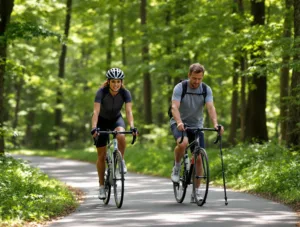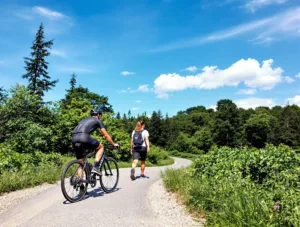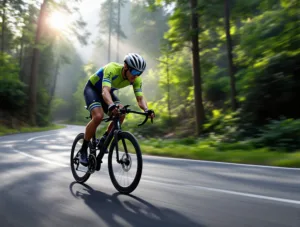The Best Time to Cycle for Faster Fat Burning: Morning vs. Evening Workouts
Introduction
Cycling is one of the most effective forms of exercise for fat burning, cardiovascular health, and overall fitness. However, the timing of your cycling sessions can significantly impact your results. Should you cycle in the morning on an empty stomach to maximize fat oxidation, or is an evening ride better for performance and calorie burn? This article provides a comprehensive analysis of the benefits of morning vs. evening cycling for fat loss, backed by science and practical insights.
We’ll explore how your body’s circadian rhythm, metabolism, and hormonal fluctuations influence fat burning at different times of the day. Additionally, we’ll provide actionable tips to optimize your cycling routine based on your fitness goals, schedule, and personal preferences.
The Science of Fat Burning and Exercise Timing
Before diving into the best time to cycle, it’s essential to understand how the body burns fat during exercise. Fat oxidation depends on several factors, including:
- Insulin Sensitivity – Higher in the morning, which may enhance fat utilization.
- Hormonal Levels – Cortisol (a stress hormone that promotes fat breakdown) peaks in the early morning.
- Glycogen Stores – Lower in the morning, potentially forcing the body to rely more on fat for energy.
- Body Temperature & Performance – Higher in the late afternoon, which may improve endurance and power output.
Research suggests that fasted morning cycling (before breakfast) may increase fat oxidation, while evening cycling may lead to higher intensity and calorie expenditure due to better physical readiness.
Benefits of Morning Cycling for Fat Loss
1. Enhanced Fat Oxidation
Cycling in a fasted state (before eating) forces the body to rely more on stored fat for energy since glycogen levels are depleted overnight. A 2019 study published in the Journal of Clinical Endocrinology & Metabolism found that fasted exercise increased fat burning by up to 20% compared to fed-state exercise.
Practical Tip:
- Keep your morning ride at a moderate intensity (60-70% of max heart rate) to optimize fat burning without excessive muscle breakdown.
2. Boosted Metabolism Throughout the Day
Morning exercise can elevate your excess post-exercise oxygen consumption (EPOC), meaning your body continues burning calories at a higher rate even after your workout.
Practical Tip:
- Combine cycling with short bursts of high-intensity intervals (HIIT) to maximize EPOC effects.
3. Improved Consistency & Mental Clarity
Morning workouts reduce the likelihood of skipping sessions due to daily distractions. Additionally, cycling early can enhance mental focus and reduce stress levels throughout the day.
Benefits of Evening Cycling for Fat Loss
1. Higher Performance & Intensity
Studies show that muscle strength, endurance, and reaction time peak in the late afternoon due to elevated body temperature and optimized neuromuscular function. This allows for more intense workouts, leading to greater calorie expenditure.
Practical Tip:
- Use evening sessions for high-intensity interval training (HIIT) or hill climbs to maximize calorie burn.
2. Better Recovery & Muscle Growth
Evening workouts align with natural testosterone production, which aids muscle repair and growth. Additionally, post-workout meals can be timed to optimize recovery.
Practical Tip:
- Consume a protein-rich meal within 30-60 minutes after cycling to support muscle recovery.
3. Stress Relief & Improved Sleep (For Some)
While intense late-night exercise may disrupt sleep for some, moderate cycling in the early evening can reduce stress and improve sleep quality by lowering cortisol levels.
Which Is Better for Fat Loss: Morning or Evening Cycling?
The answer depends on your goals, schedule, and body’s response:
| Factor | Morning Cycling | Evening Cycling |
|---|---|---|
| Fat Oxidation | Higher (fasted state) | Lower (but higher calorie burn from intensity) |
| Performance | Lower (due to low glycogen) | Higher (better strength & endurance) |
| Consistency | Easier to stick to | Risk of skipping due to fatigue |
| Recovery | Slower (without post-workout meal) | Faster (better nutrient timing) |
Best Choice For:
- Maximizing Fat Burn → Morning (fasted, moderate pace)
- Maximizing Performance & Calorie Burn → Evening (higher intensity)
Practical Tips to Optimize Fat Burning Through Cycling
1. Try Fasted Morning Rides (If Tolerated)
- Keep sessions under 60 minutes to avoid muscle loss.
- Hydrate well and consider black coffee to enhance fat oxidation.
2. Use Evening Rides for High-Intensity Workouts
- Focus on sprints, intervals, or resistance cycling to maximize calorie burn.
3. Mix Both for Balanced Results
- Alternate between fasted morning rides (3x/week) and intense evening sessions (2x/week).
4. Prioritize Sleep & Recovery
- Poor sleep increases cortisol, which hinders fat loss. Aim for 7-9 hours per night.
Final Verdict: When Should You Cycle for Faster Fat Loss?
Both morning and evening cycling have unique fat-burning advantages. If your primary goal is fat oxidation, morning fasted rides may be more effective. However, if you seek higher performance and total calorie burn, evening cycling could yield better results.
Best Approach:
- Experiment with both timings to see how your body responds.
- Combine both strategies for a balanced fat-loss and fitness plan.
- Stay consistent—timing matters, but regular cycling is the key to long-term success.
Ultimately, the best time to cycle is when you can stick to it consistently. Whether you’re an early riser or a night rider, cycling at any time of day will contribute to fat loss, improved health, and enhanced well-being.
Would you like any modifications or additional details on specific aspects of cycling for fat loss?









Add comment